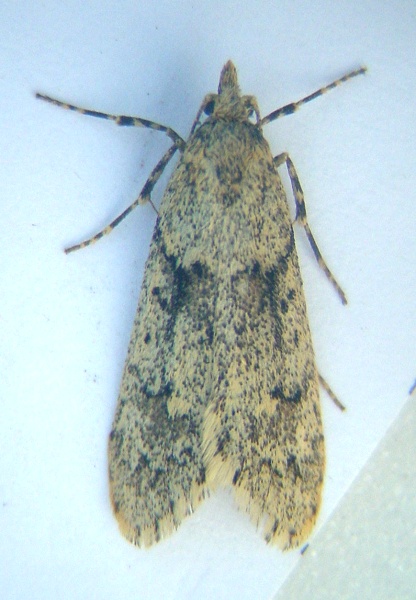29.001 BF663
Diurnea fagella
([Denis & Schiffermüller], 1775)
Wingspan 19-29 mm.
This is an early spring species, occurring from March to May.
It is quite a small moth, with an average wingspan of about 25mm. Present throughout much of Britain, the melanic form occurs in some northern and industrial areas.
The females have much shorter, stunted wings than the males.
The caterpillars feed on various deciduous trees.
- Description (Ian F. Smith):
Early stages: Foodplants: Quercus, Fagus, Carpinus, Betula, Salix, Prunus, Populus, Corylus, Typha, Acer campestre, Rubus fruticosus, and other trees and shrubs. In a sandwich of two leaves sewn flat together.
Ova: March and April. Laid in a batch of 100 or more on twig or shoot. Ovum 0.6 mm long. Smooth shiny cylinder with hemispherical ends. Often crumpled. Day 2 buff. Day 7 red. Day 20 reddish yellow, showing black head and prothoracic plate of un-hatched larva. Day 21 larvae hatch. (Indoors; may take longer outside.)
Early and intermediate larval instars
Length: Lengths stated for different stages are approximate and subject to variation. Individual larvae can decrease in size for a time if poorly fed.
Head: 2 mm hatchling; black.(visible in ova before hatching). 7 mm; pitchy black with mid brown mouthparts. 8 mm; pitchy brown with brown frons and mouthparts. Peach spot to either side of frons. 8.5 mm; dark brown with peach band across frons and anterior of epicranial spheres. 11 mm; Pale peach, heavily marked brown ochre in posterior half. Mouthparts dark chestnut. Stemmata linked by curved black band.
Prothoracic shield: 2 mm; grey-black. 7 mm; black. 8 mm; translucent brown with broad black border laterally, along posterior and on posterior half of dorsum. 8.5 mm; greenish brown with large black area laterally. 10.5 mm; greenish yellow with black lateral spot. 11.5 mm; greenish yellow with no black lateral spot, but perhaps an obscure brown ochre mark in its place.(Black lateral spot may persist on larger larvae, but usually gone by 20 mm)
Thoracic legs:More or less concolorous with body. All instars, including hatchlings, have third leg with swollen bulbous tibia and tarsus held at right angles to body. Body: 2 mm; translucent yellow showing pinkish gut. 7 mm; yellowish white and yellow. 8.5 mm; grey or greyish green. Paler intersegmentally. Whitish gonads. 10.5 mm greyish green. Paler intersegmentally. Lighter gonads.
Spiracles: Concolorous, unobtrusive.
Pinacula: Concolorous, unobtrusive.
Setae: Transparent, colourless.
Anal plate: Concolorous. Some transparent marks show darker viscera.
Prolegs: Concolorous.Final larval instar
Length: 25 mm described, may reach 28 mm.
Head: Pale peach, heavily marked brown ochre in posterior half Posterior thinly edged reddish brown. Mouthparts rich chestnut, edged black. Stemmata linked by curved black band.
Prothoracic shield: Translucent green. Sometimes an obscure faint brown ochre lateral mark.
Thoracic legs: Translucent greenish white. Claw pitchy brown. Third leg with swollen bulbous tibia and tarsus held at right angles to body. Can be drummed rapidly.
Body: Dull greyish green. Opaque, so gonads may be obscure. Intersegmentally yellowish green. Dark contractile vessel visible as a darker dorsal line.
Spiracles: Concolorous, unobtrusive.
Pinacula: Concolorous, shiny.
Setae: Fine, transparent, colourless.
Anal plate: Concolorous. Some transparent marks show darker viscera.
Prolegs: Concolorous translucent. Many small light brown crochets.
Similar species: Final instar D. fagella larvae can easily be mistaken (e.g. p44 in Waring & Townsend) for 1655 Tethea or or (Poplar lutestring), but the swollen third leg of D. fagella separates them. Two other British species have swollen third legs: 664 Diurnea phryganella, on Quercus and, occasionally, Vaccinium myrtillus, Populus tremula, and Tilia cordata, has a brown head, yellow prothoracic plate, yellowish green thoracic legs and a yellowish green body (MBGBI 4-1). 665 Dasystoma salicella on Myrica, Salix, Prunus spinosa, Filipendula, Potentilla anserina, Rubus fruticosus, Rhamnus etc. has a black (MBGBI 4-1) or brown (Emmet 1988 and Spuler) head. Its prothoracic plate is yellow-green edged brown posteriorly (Emmet 1988) or greenish brown with darker posterior ( MBGBI 4-1). It has grey pinacula and a green anal plate with blackish speckles. The thoracic legs are pale green, marked dark brown, first pair darker (MBGBI 4-1). Full grown larva about 20 mm. Several of the characters of these two species appear at some stage of the development of Diurnea fagella. The differences may hold true for larvae over 20 mm, but rearing is advised to confirm their identity.
Rearing:
Diurnea fagella grows slowly over five months, so rearing on a potted plant or a sleeved branch is easier than maintaining a supply of fresh cut plant material. Leave outside overwinter and bring indoors in March.

 UKMoths
UKMoths 











